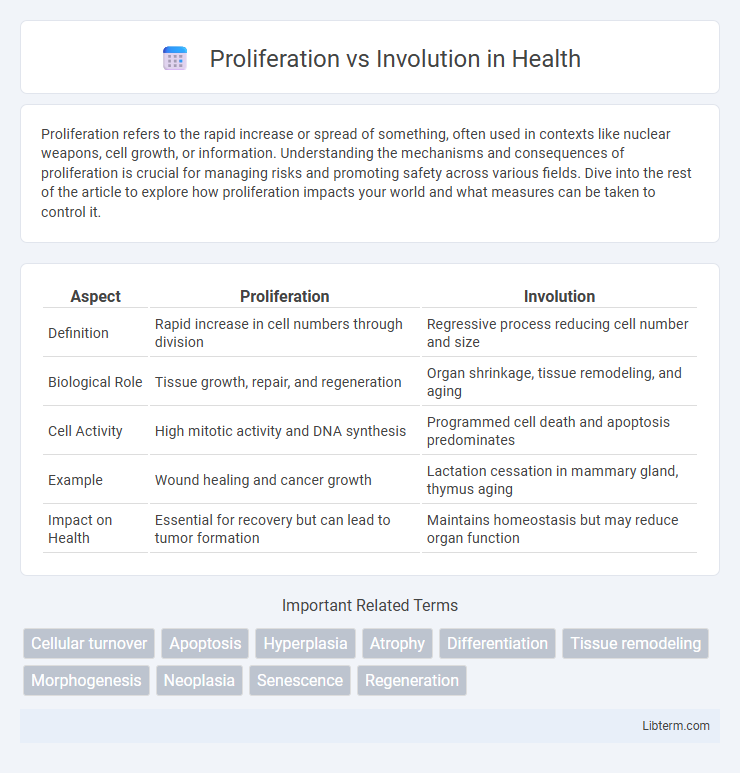Proliferation refers to the rapid increase or spread of something, often used in contexts like nuclear weapons, cell growth, or information. Understanding the mechanisms and consequences of proliferation is crucial for managing risks and promoting safety across various fields. Dive into the rest of the article to explore how proliferation impacts your world and what measures can be taken to control it.
Table of Comparison
| Aspect | Proliferation | Involution |
|---|---|---|
| Definition | Rapid increase in cell numbers through division | Regressive process reducing cell number and size |
| Biological Role | Tissue growth, repair, and regeneration | Organ shrinkage, tissue remodeling, and aging |
| Cell Activity | High mitotic activity and DNA synthesis | Programmed cell death and apoptosis predominates |
| Example | Wound healing and cancer growth | Lactation cessation in mammary gland, thymus aging |
| Impact on Health | Essential for recovery but can lead to tumor formation | Maintains homeostasis but may reduce organ function |
Understanding Proliferation and Involution
Proliferation refers to the rapid multiplication of cells, essential for growth, tissue repair, and regeneration, driven by signaling pathways such as the MAPK and PI3K-AKT cascades. Involution is the process of programmed cell shrinkage and tissue regression, commonly occurring after functional phases like lactation, mediated by apoptosis and autophagy mechanisms. Understanding these cellular behaviors is crucial for insights into developmental biology, cancer progression, and tissue homeostasis.
Biological Mechanisms Behind Proliferation
Cell proliferation involves a complex orchestration of molecular pathways including growth factor signaling, cell cycle regulation, and DNA replication to promote cellular division and tissue expansion. Key regulators such as cyclins, cyclin-dependent kinases (CDKs), and tumor suppressor proteins like p53 coordinate phases of the cell cycle to ensure accurate duplication and prevent uncontrolled growth. This biological mechanism supports tissue regeneration and development, distinguishing it markedly from involution processes driven by programmed cell death and tissue regression.
Key Drivers of Cellular Involution
Cellular involution is primarily driven by programmed cell death mechanisms such as apoptosis, influenced by factors including hormonal fluctuations, oxidative stress, and immune system signaling pathways. Key drivers include decreased growth factor signaling, elevated pro-inflammatory cytokines, and activation of caspase enzymes that dismantle cellular components. These molecular triggers contrast with cellular proliferation, which is regulated by mitogenic signals, growth factors like EGF and PDGF, and cell cycle progression factors.
Proliferation in Health and Disease
Proliferation is the process of cell division and growth essential for tissue development, repair, and regeneration, regulated by growth factors and signaling pathways such as MAPK and PI3K-Akt. Dysregulated proliferation contributes to diseases like cancer, where uncontrolled cell division leads to tumor formation and metastasis. Understanding proliferation mechanisms aids in developing targeted therapies for regenerative medicine and oncology.
Involution: Role in Tissue Remodeling
Involution plays a critical role in tissue remodeling by orchestrating the regression of temporary structures and restoring tissue homeostasis after developmental or physiological processes. This mechanism involves programmed cell death, extracellular matrix reorganization, and cellular differentiation adjustments to refine tissue architecture. Effective involution ensures the removal of excess cells, maintains organ function, and prepares the tissue for subsequent regenerative events.
Proliferation vs Involution: Core Differences
Proliferation refers to the rapid multiplication of cells through processes like mitosis, leading to tissue growth or regeneration, while involution is the shrinking or return of an organ or tissue to a previous size, often through programmed cell death or apoptosis. Proliferation results in an increase in cell number and tissue mass, essential in development and healing, whereas involution involves reduction and functional decline, commonly observed after lactation or immune response. The core difference lies in proliferation driving expansion and growth, whereas involution promotes regression and restoration to a baseline state.
Regulatory Signals Governing Both Processes
Regulatory signals governing proliferation and involution involve intricate molecular pathways where growth factors like epidermal growth factor (EGF) and transforming growth factor-beta (TGF-b) promote cell division, while apoptotic signals triggered by caspases and Bcl-2 family proteins initiate programmed cell death during involution. The balance between proliferative signals mediated through the PI3K/AKT and MAPK pathways and involution signals via cytokines such as tumor necrosis factor-alpha (TNF-a) determines tissue remodeling outcomes. Hormonal regulation by estrogen, progesterone, and prolactin further modulates these pathways, finely tuning cellular responses in dynamic physiological contexts like mammary gland development and regression.
Clinical Implications of Proliferation and Involution
Proliferation, characterized by increased cellular growth, often signals pathological conditions such as tumor development or hyperplasia, necessitating early clinical intervention for prevention and treatment. Involution involves the regression or shrinkage of tissues, commonly observed during the resolution phase of inflammation or post-lactation breast tissue remodeling, providing insight into normal tissue homeostasis and recovery processes. Clinicians monitor proliferation markers like Ki-67 and apoptosis indicators during involution to assess disease progression and treatment efficacy.
Therapeutic Strategies Targeting Proliferation and Involution
Therapeutic strategies targeting proliferation focus on inhibiting cell cycle regulators such as cyclin-dependent kinases (CDKs) or growth factor receptors like EGFR to suppress uncontrolled tumor growth. In contrast, interventions aimed at promoting involution enhance programmed cell death pathways, including apoptosis and autophagy, to remove damaged or diseased cells effectively. Combining proliferation inhibitors with agents that trigger involution mechanisms offers a synergistic approach to treating cancers and tissue hyperplasia by both halting cell expansion and facilitating the clearance of aberrant cells.
Future Research Directions in Proliferation and Involution
Future research directions in proliferation and involution emphasize investigating molecular signaling pathways and gene expression profiles that distinguish cellular growth from regression. Advanced omics technologies and single-cell analysis are critical for elucidating the dynamic regulatory networks driving tissue expansion versus shrinkage. Integrating computational modeling with experimental biology aims to uncover therapeutic targets for diseases characterized by abnormal proliferation or involution processes.
Proliferation Infographic

 libterm.com
libterm.com